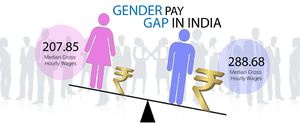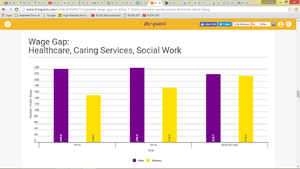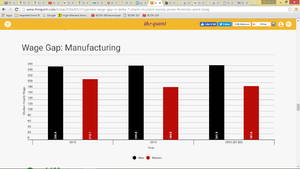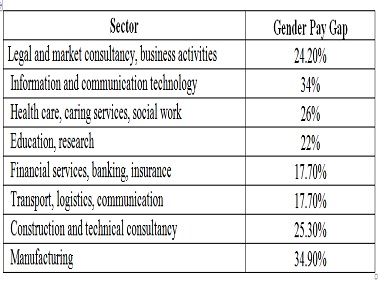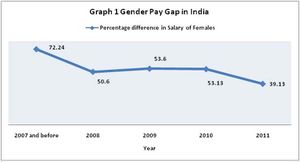GRSJ224/FeminismInIndia
Feminism and Wage Gap in India
- While India is considered to be one of the most progressive countries in the world, there are a few issues such as the issue of Gender inequality that is said to hamper the growth of the country. Gender Inequality and its social causes, impact India's sex ratio, women's health over their lifetimes, their educational attainment, and economic conditions. [1] The built up of such issues over the time has led to a formation of a community often referred to as 'Feminists' in the country. Feminism in India is a set of movements aimed at defining, establishing, and defending equal political, economic, and social rights and equal opportunities for Indian women.[2]
- Unlike the western feminist movement, India observed its first movement for equality post independence, where Indian men fought for women's rights and successfully abolished the Sati System (where women were burned in their husband's funeral pyre), abolished child marriage & disfiguring of widows, and procured voting, property, abortion and adoption rights for women.[3]. However, even after overcoming major gender disparity problem, one important issue that is debatable in today's times is the issue of Gender Wage Gap in India.
History
From the beginning of time, the Indian society has had strongly rooted cultures and traditions that have promoted male-dominance. According to the Foundation for sustinable development organization[4] , traditional patriarchal norms have relegated women to secondary status within the household and workplace. This has led to a drastic affect on women's health, financial status, education, and political involvement.
Causes
Skill development
Patriarchal laws have divided the society such that women are expected to raise children, while men are considered as the sole bread-winners in the family. In the skilled labour market, women are unable to put in as many hours as the men since they are responsible for domestic child care and unpaid domestic work. [5]
Participation in the workforce
Women participate in the unorganized sectors more than men do, and wages tend to be lower in the unorganized sector. Besides that, female participation has also been higher in the informal sectors that include care-giving and agriculture.[6]
Education
The patriarchal law believes that education is not as imporant for women and that they are only supposed to be home-makers.Even today, many women lack education and hence become incompetent in the work field.
Effect
The Monster Salary Index for the year 2013, 2014 and 2015 reveals unanticipated data as shown in the table below. It clears all the doubts against wage disparity in India and provides a clear image indicating how we need to work hard towards narrowing this wage gap.
The graphs (on the right) developed by the The Quint[7] help identify the wage gap in various occupational sectors, suggesting that the wage gap is maximum in the Manufacturing sector.
Role of Feminism
Indian Constitution
Moreover, the Indian constitution too has recognized the importance of wage equality and has amended the constitutional privileges. It demands the State to direct its policy towards securing for men and women equally the right to an adequate means of livelihood (Article 39(a)); and equal pay for equal work for both men and women (Article39(d)). [8]
Narrowed gap
The continuous struggle by women and men to gain equality over the years has made a difference. According to the Paycheck.in, the average gender pay gap is approximately 54% for years 2006 to 2011. However, the data collected reveals that gender pay gap has narrowed over the years. It was above 70% before 2008 and has come down to almost 40% in 2011. [9]
Current situation
On a positive note, it is good news for the country that more people including women and men from different classes are standing up against gender wage gap in various formal industries. In other informal industries like TV and films industry (which has a huge impact on the nation), many actresses are voicing their opinion against unfair wage gap, as mentioned in the [10]. These factors have successfully been able to guide the youth towards building a more equal society.
Conclusion
It is extremely important for us as a society to understand and implement feminist ideologies in the society, be it in terms of providing equal wage and equal opportunities or equal status to women in the society. We need to realize that equality in wage results in equal status of women, which will further lead to growth of the country as a whole.
References
- ↑ https://en.wikipedia.org/wiki/Gender_inequality_in_India.
- ↑ https://en.wikipedia.org/wiki/Feminism_in_India.
- ↑ Chaudhuri, Maitrayee. Feminism in India (Issues in Contemporary Indian Feminism) New York: Zed, 2005.
- ↑ http://www.fsdinternational.org/country/india/weissues
- ↑ [Anupam Manuhaar, Shayan Javeed (April 2013). "Women and Wage Discrimination in India: A Critical Analysis" (PDF). International Journal of Humanities and Social Science Invention 2 (4): 6–12.].
- ↑ Anil Kumar Mishra, Tauffiqu Ahamad, Jitendra Kumar Pandey, (December 2014). "The Status of Women Workers in the Unorganized Sector.
- ↑ http://www.thequint.com/india/2016/05/25/gender-wage-gap-in-india-7-charts-monster-survey-prove-feminists-arent-lying
- ↑ http://mospi.nic.in/mospi_new/upload/man_and_women/Constitutional%20&%20Legal%20Rights.pdf
- ↑ http://www.paycheck.in/main/world-map-gender-pay-gap/gender-pay-gap-in-india-1
- ↑ Hindustan Times
